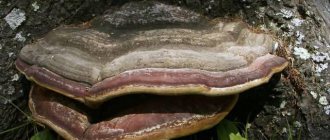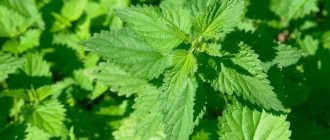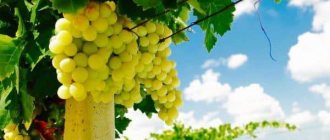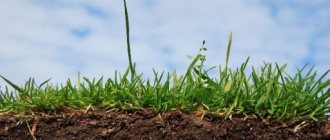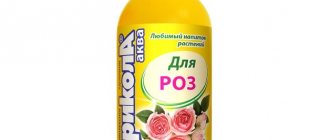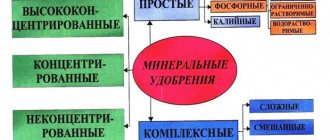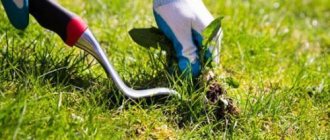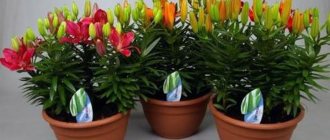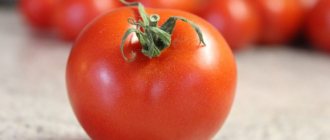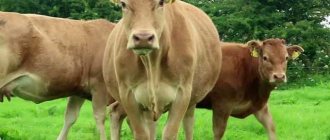Soil is a complex biological complex that includes mineral (mechanical) and organic parts, soil air, water, microflora and microfauna. The quality of growing garden crops on your garden plot depends on this complex and a set of influencing factors, such as climatic conditions, planting dates, variety, timeliness and correctness of agrotechnical practices. Also equally important when starting a garden, lawn or planting a vegetable garden is the type of soil . It is determined by the content of mineral and organic particles.
The choice of crops, their placement, and ultimately the harvest depends on what type of soil predominates on your site. Depending on this, a specific complex is developed to maintain fertility through proper processing and application of the necessary fertilizers.
The main types of soils that owners of household plots and summer cottages most often encounter are: clayey, sandy, sandy loam, loamy, calcareous and marshy. A more precise classification is as follows:
- By mechanical composition - sandstones, sandy loams, loams, alumina.
- By organic composition - chernozems, sierozems, brown and red soils.
Each soil has both positive and negative properties, which means it differs in recommendations for improvement and selection of crops. In their pure form they are rare, mostly in combination, but with a predominance of certain characteristics. Let's look at each type in detail.
What is the main characteristic of any soil?
There are different types of soil, each ideal for growing different plants (food crops) or just flowers. Fertile black soil is well suited for forming flower beds; sandy soil is better for lawns; clay soil is more suitable for forming a landscape, as it holds its shape well and does not wash out.
Although different types of soil have a wide range of colors, textures and other distinctive features, there are only three types of soil particles that geologists consider distinct. Their difference depends on the presence of sand, loam and clay in the composition. Unfortunately, on many properties, the quality of the soil decreases during the construction period, which later requires the addition of pure types on top of the existing soil so that the plants feel more comfortable in it and receive a balanced amount of nutrients.
Peaty-swampy soil
The main composition of the soil is components of organic origin. Contains nitrogen and phosphorus in a form unsuitable for absorption by plants. This soil is characterized by a high level of air and water permeability. Due to high humidity, the soil does not warm up well. Quickly absorbs and releases moisture.
To plant and arrange a lawn on peat soil, it is necessary, first of all, to normalize the process of decomposition of organic elements. To increase porosity, clay flour, coarse sand, and compost are added. To increase the soil microflora, it is recommended to add sawdust, rotted manure, compost, potash and phosphorus fertilizers.
Silt
These soils are composed of small particles of river plants and are quite porous, so they often need to be compacted with various garden tools. They are susceptible to washout and wind erosion if they are not covered with natural vegetation cover as soon as possible. However, silt contains more nutrients, unlike sandy soils and even chernozem, and is capable of retaining moisture for a long time, therefore, as a rule, it is quite fertile. The density of this composition is increased artificially by adding various organic substances to the soil.
Calcareous or chalk soils
Calcareous soil is a soil consisting mainly or partly of calcium carbonate, in other words, containing lime or being chalky. The term limestone can be applied to sedimentary rock that is formed from (or contains large amounts of) calcium carbonate in the form of calcite or aragonite.
Calcareous deposits typically form in shallow waters close to land as carbonate is deposited by marine organisms that rely on land-based nutrients. In some areas, layers of limescale deposits may form on the shores due to storms or changes in ocean currents.
Interesting!
The most common form of calcium silt found on ocean shores is a form of calcium carbonate derived from planktonic organisms that accumulates on the seafloor. Then the banks change their shape or the depth becomes shallower, exposing such layers.
Calcareous soil is relatively alkaline, in other words, it has a high pH. This is due to the very weak acidity of carbon dioxide. The reason for the presence of large amounts of calcium carbonate in the starting material is a layer of secondary accumulation of carbonates (usually calcium or Mg) in quantities exceeding 15% calcium carbonate equivalent.
Since chalk is alkaline in composition, they are absolutely not suitable for climbing plants that need acidic soil. Chalk soil can be crumbly and fine, but most often contains rather large lumps of white chalk stone. It is almost impossible to acidify such soil artificially, but the chalk composition is ideal for plants that require an alkaline environment.
The advantage of such land is good drainage. Water can be retained by adding a small amount of fine-grained clay. This will also increase the amount of nutrients that are initially very low in the chalk.
Soil types. Classification
types of soils there are . Everything is so complicated with the classification of soils that it turns out that there is still no single world standard for systematizing the soil on our planet. For example, let’s look at the type of soil – “chernozem”. Depending on the location, it can be described as follows:
- type - black soil,
- subtype - ordinary chernozem,
- genus - ordinary solonetzic chernozem,
- species - ordinary solonetzous, low-humus chernozem,
- variety - ordinary solonetzic, low-humus, silty-loamy chernozem,
- category - ordinary solonetzic, low-humus, silty-loamy chernozem on loess-like loams.
The most common type of soil in our country is podzolic and, usually, they are found in the forest zone. These are poor, most often acidic soils with a low content of organic matter in them. In the presence of a large amount of water, bog-podzolic soils are formed. In mixed forests, peat appears in swamps. This soil is distinguished as high peat bog and lowland peat bog .
In low-moisture areas, soddy-podzolic soils are obtained. In these same places there are areas with brown soils. In the forest-steppe and steppe zones, finally, there are chernozems, the richest lands . They say about black soil: bury a cigarette butt in it and a pack of cigarettes will grow .
And there are gray soils, yellow soils, red soils, solonchak soils, dark and light chestnut soils, etc. , in total about 90 different types. In general, we walk on the earth, trample it mercilessly, litter and litter it. We don’t save at all! But it took hundreds of millions of years for it to form. And there is no spare Earth, if suddenly - WHAT.
In general, you understand that soil is a very complex thing. We, in fact, do not need to know all the intricacies of the soil formation process. Let's agree that we will distinguish soils by their mechanical composition and taking into account how fertile they are, light or heavy, wet or dry, acidic or alkaline. And we’ll figure out how to cultivate the soil.
Clayey
Clay has the smallest particle size of all soil types. This allows a large number of clay particles to occupy the entire space, sticking together without the slightest gap. This feature plays a big role in the formation of the smooth texture of the clay.
Due to the small particle size of clay soils, they have a very dense structure. Clay particles are usually so tightly bound to each other that such density simply does not allow plant roots to break through such soil. Clay is heavier than any other soil, does not warm up well in cold weather, and its high density makes clay deposits more resistant to erosion than sandy or loamy deposits.
What grows on clay? It contains very little organic material. Without the addition of organic matter, clay-heavy soil usually lacks the nutrients and trace elements necessary for plant growth and proper photosynthesis. Mineral-heavy clay soils can be alkaline in nature, resulting in the need for additional intervention to balance the soil pH before planting.
One of the problems with clay soil is its low permeability, resulting in very high water holding capacity. Because soil particles are small and close together, water takes much longer to travel through clay soil.
Clay particles absorb this water over time, expanding as they do and further slowing the flow of water through the soil.
Description and characteristics of species
The soils that gardeners, gardeners, and agronomists most often work with are:
- sandy;
- sandy loam;
- loamy;
- clayey;
- peat.
Properly organizing planting means knowing the characteristics of the soil and how to improve its properties through proper cultivation, application of the necessary minerals and fertilizers.
sandy soil
This is a light type of soil consisting mainly of sand grains and a small portion of clay particles. It allows water to pass through well and is extremely free-flowing. If you take a handful of earth in your palm, you won’t be able to form a lump out of it. She's falling apart. Its other qualities are high breathability, thermal conductivity, and easy workability. It is difficult to apply fertilizers to such soil. They do not stay there, they go along with the water into deeper ground layers.
Such lands are poor and not very suitable for growing crops. But growing garden trees, as well as carrots, onions and strawberries on it is quite acceptable. To cultivate sandstone, it is good to introduce peat, humus and clay flour.
Sandy loam type
This soil has better properties , similar in composition to sandy soil, but still contains a higher percentage of clay impurities. By taking a handful in your hand and squeezing it, you can get a lump. But it doesn't hold its shape well. The qualities of such soil are more valuable. It retains moisture and minerals better, is breathable, dries out more slowly, warms up better, and is easier to process. You can grow all crops, not forgetting about methods of increasing soil fertility. Ways to improve such soil: applying potash and organic fertilizers, mulching, green manure and fairly frequent loosening.
Loamy lands
The best type of soil in terms of characteristics is also called loam. Contains the largest percentage of nutrients. It retains moisture well and is endowed with the ability to distribute it throughout the horizon. Easy to handle and retains heat. Such a sample forms a lump well and can be rolled out into a “sausage”, but cannot be bent into a ring. This is a special technique in agronomy for determining the mechanical composition of the soil. Such land does not need to be improved, but only to maintain its fertile properties, for which purpose it is mulched and humus is added when digging in the autumn.
Seed stratification: its role in plant life, types and methods
The soil is clay
Or clayey, as it is also called . Clay content up to 80%. It is very heavy and dense, does not absorb water well, and sticks to shoes when wet. The structure is lumpy.
If you take a lump of damp earth, you can easily form a long sausage and roll it into a ring. At the same time, it will not crack or tear.
We can say that it looks like plasticine. Accordingly, its qualities deteriorate: it contains little air, does not warm up well and allows water to pass through. It is not easy to grow garden crops on such land.
Proper cultivation will help such land become fertile. To do this, lime, ash, compost, and manure are regularly added. Careful loosening and mulching will also be beneficial.
What is loamy soil?
These soils are a gardener's best friend. It is believed that the loamy soil layer has an ideal balance of all types , and the sizes of all particles have the following characteristics: clay - less than 0.002 mm, silt - 0.002-0.05 mm, sand: 0.05-2 mm, hard rocks (stones) not more than 2 mm.
Also, the loamy mixture contains calcium carbonate or lime in sufficient quantities.
Sandy
Sand is small pieces of eroded rock with a grainy texture. In sandy soils, most of them have a diameter of more than 2 mm. The composition of the soil in which the percentage of sand is very high is called sandy.
Sand particles are the largest in size when compared to other types. It is considered light and usually consists of 35% sand, less than 15% silt and clay with various impurities, usually dry, moderately nutritious and drains quickly. Often used for growing potatoes and tomatoes.
The advantage of this soil is that sandy soil has excellent drainage properties. In gardening and landscaping it is often used to improve drainage.
Sand also filters water very well, thanks to which other plants (located down the slope from the sand mounds) receive exceptionally clean moisture without unnecessary impurities.
How to most accurately determine soil acidity
Soil acidity is one of the most important characteristics in agriculture. In summer cottages, soils are most often acidified or have a neutral reaction. Alkaline ones are rare and mainly occur if procedures to reduce acidity were carried out incorrectly.
Several methods are used to determine soil pH levels. litmus paper (color tests) has become widespread To carry out the test, the soil is wrapped in a piece of cloth and placed in water in a 1:1 ratio.
Unfortunately, such measurements are not always correct, because peat and clay, for example, contain many colloidal particles, making positively charged ions difficult to detect. As a result, the litmus test shows a neutral level of acidity, while the soil is actually acidic. A pH meter , a device for measuring the pH value of a soil solution, has the same errors
What to do in this case? Try other methods at the same time. Thus, determining acidity using indicator plants . Read more about this in our article.
- Indicator plants - how to determine the composition and acidity of the soil on the site
Find out the composition of the soil in the garden, vegetable garden and flower bed without chemical analysis.
Acidic soil on a site is also easily determined by the following signs:
- plants often get sick: clubroot appears in radishes and cabbage, onions suffer from neck rot, stone fruit trees shed their ovaries;
- when dry, the earth cakes in large pieces;
- a white layer resembling ash is visible in the layer of earth.
You can also try the traditional method of determining soil acidity. To do this, place several leaves of blackcurrant or cherry in a glass container and pour boiling water over it. Afterwards, cool and place some soil from the site into the water. If after some time the water:
- turns red - the soil is acidic;
- turned blue - slightly acidic;
- turns green – the reaction is neutral.
- Soil acidity: determine and regulate
If your soil is highly acidic, this can seriously harm your plants. How do you know when it's time to take action?
What is sandy loam soil?
Sandy loam soils are dominated by sand particles, but also contain enough clay and sediment to provide little fertility compared to sand. There are four different types of sandy loam soils, which are classified according to the size of the sand particles:
- coarse sandy loam;
- fine sandy loam;
- sandy loam;
- very fine sandy loams.
The size of sand particles is measured in millimeters, and their concentration in the soil is used to determine which category the soil falls into. Sandy loam soils consist of approximately:
- 60% sand;
- 10% clay;
- 30% sludge particles.
When sandy loams are compressed, they retain their shape (almost like clay), but disintegrate easily when they dry out. Sandy loam soils have a high concentration of sand, which gives them a grainy appearance. In gardens and vegetable gardens, this type of soil is used to quickly remove excess water. Plants grown in this type of soil require more frequent watering and more fertilizer than soils with higher concentrations of clay and minerals.
Chernozem
Chernozem is a black soil containing a high percentage of humus (from 4% to 16%) and a high percentage of phosphoric acid, phosphorus and ammonia (the composition of such soil may vary depending on climatic conditions). Chernozem is very fertile and can produce high yields in agriculture due to its high moisture capacity. The black soil, rich in organic matter, was first discovered by Russian geologist Vasily Dokuchaev in 1883 in the high steppe of European Russia.
Chernozems occupy about 230 million hectares of land. There are two “black earth belts” in the world, one of them is the Eurasian steppe (from eastern Croatia to northeastern Ukraine through the Central Black Earth region of central Russia and further into Russia), and the other is the Canadian prairie (from Kansas, through Texas and almost to throughout Canada).
The thickness of the chernozem layer can vary significantly: from a few centimeters to 1.5 meters (in Ukraine, as well as in the Red River Valley region in the northern USA, in the area of Lake Agassiz, Canada).
Relationship between soil and natural areas
This table suggests considering the correspondence between ecosystem types and main soil classes.
| Zone name | Soil type | Humus content | Soil properties | Soil formation conditions |
| Arctic deserts | Arctic | Very little | Barren | Lack of heat and vegetation |
| Tundra | Tundra-gley | Few | Low-power, gley layer | Permafrost, little heat, waterlogging |
| Taiga of the European part | Podzolic | Slightly | Washing, sour | Fallen pine needles strongly oxidize the soil, permafrost |
| Taiga of Eastern Siberia | Taiga-permafrost | Slightly | Infertile, cold | Permafrost |
| Mixed forests | Sod-podzolic | More than in podzolic | More fertile | Spring flushing, more plant residues |
| Broadleaf forests | Gray forest | 4-5% | More fertile | Mild climate, fallen tree leaves are rich in ash elements |
| Steppes and forest-steppes | Chernozems, chestnut | 10-12% | The most fertile | Lots of plant residues, warm climate |
| Semi-deserts | Brown, gray-brown | Less humus | Soil salinization | Dry climate, sparse vegetation cover |
| Deserts | Desert yellowish gray | Few | Due to rare rains, salts are almost not washed away | Lack of moisture and poor organic matter |
| Hard-leaved evergreen forests and shrubs | Brown | Humus content 4-5%, good fertility | High fertility with sufficient moisture | The growing season lasts all year round |
| Tropical rainforests | Red-yellow ferralitic and red-brown | The proportion of humus is 3-10% | Good soil leaching, high iron hydroxide content | High humidity, year-round high temperatures, huge plant biomass |
The diversity of surrounding landscapes and climates affects the fertility of the land in different ways. Thus, some soils can give rise to a huge number of agricultural crops, while others are practically infertile.
